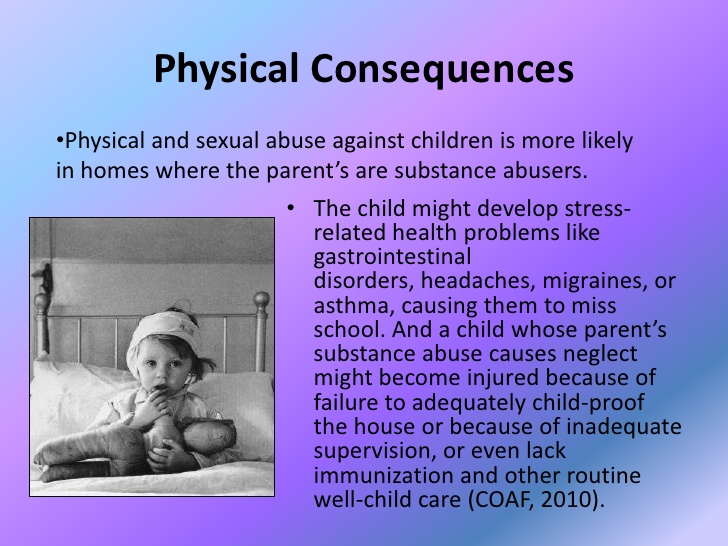Determining how tall your child will be
Child's Height at Age 2 May Predict Adult Height
-
By
Shawn Bishop
September 24, 2010
Dear Mayo Clinic:
Is it true that a child's future height can be predicted when they are 2 years old, based on their size at that time?
Answer:
A child's height at age 2 may be predictive of final adult height. But many factors can affect height. As they grow, children should be monitored regularly by a doctor to ensure they are growing properly and to detect any growth problems as soon as possible.
Doubling a child's height at age 2 can provide an estimate of how tall that child will be in adulthood. (Boys are usually a little taller than that number and girls a little shorter.) That's because by 2 most children have reached the growth chart percentile they will stay on as they grow. The percentile compares a child's height with that of other children the same age. For example, a child on the 50th percentile for height would be taller than half and shorter than half of other children his or her age.
After age 2, most healthy children grow steadily at about 2 inches per year until they reach puberty. During puberty they have a growth spurt, and shortly after that growth ends. Generally, most girls grow only about 2 inches more after they have their first menstrual period. Boys, by the time they need to start shaving and their voices deepen, have usually almost finished growing.
Genetics plays the biggest role in a person's final adult height. The best predictor of height is parents' height or, more specifically, midparental height. You can calculate midparental height by adding the mother's and father's height in inches. Add 5 more inches for boys or subtract 5 inches for girls. Divide by two. Most children will reach an adult height within 2 inches of mid-parental height.
Several factors can negatively affect final adult height.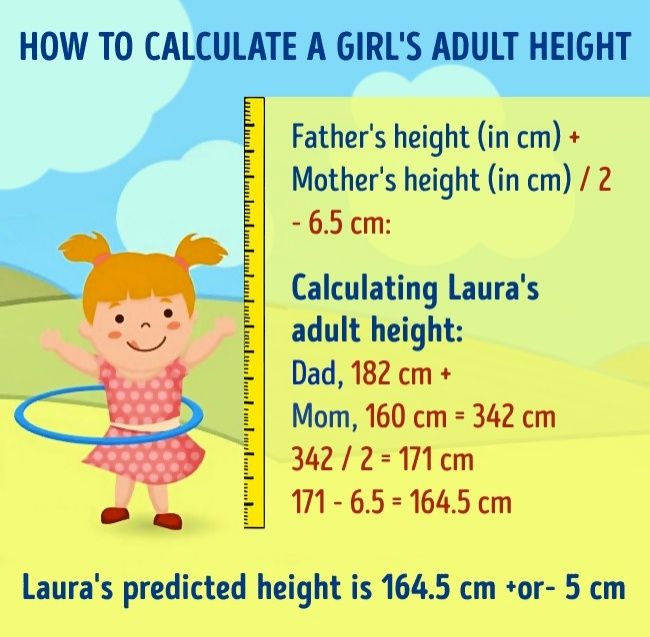 A chronic illness can considerably impede growth. Although some conditions — such as hormonal disorders (thyroid disease, growth hormone deficiency) and genetic disorders (Down syndrome, Turner syndrome) — are specifically linked to reduced adult height, any significant illness can decrease growth. Medications such as corticosteroids (e.g., prednisone or cortisone) can also reduce a child's growth and final adult height, especially if used in high doses for long periods.
A chronic illness can considerably impede growth. Although some conditions — such as hormonal disorders (thyroid disease, growth hormone deficiency) and genetic disorders (Down syndrome, Turner syndrome) — are specifically linked to reduced adult height, any significant illness can decrease growth. Medications such as corticosteroids (e.g., prednisone or cortisone) can also reduce a child's growth and final adult height, especially if used in high doses for long periods.
Being underweight can impact final height, too, particularly during stages of rapid growth such as infancy and puberty. Eating disorders like anorexia nervosa often affect teenagers and can prevent the normal growth spurt that should occur during puberty. Unfortunately, once puberty is complete, the bony growth plates are closed, and there's no opportunity to get back the missed growth.
Keep in mind, though, that eating in excess will not help a child grow taller. Children who are obese are often taller when they are younger because obesity can affect the body's bone maturation, causing more rapid growth at a younger age. Heavier grade school children may be tall, but they often finish growing sooner than their peers. Eventually, those children have the adult height that would normally be expected in their family.
Heavier grade school children may be tall, but they often finish growing sooner than their peers. Eventually, those children have the adult height that would normally be expected in their family.
If a child is healthy, they should grow at a rate of about 2 inches per year, from age 2 until puberty. If your child isn't growing at that rate, see your pediatrician or family physician. Even healthy children should be seen by their doctors at least every two years to check that growth is normal. If a child is well into puberty and a treatable growth disorder is discovered, there may not be much that can be done to change final height. If discovered earlier, however, some excellent treatments are available.
— Siobhan Pittock, M.D., Pediatric Endocrinology, Mayo Clinic, Rochester, Minn.
Related articles
Mayo hospitals continue to earn patients’ trust, 5-star ratings for patient experience
Mayo Clinic hospitals in Arizona, Florida and Rochester, Minnesota, have again received five-star ratings and most qualifying Mayo Clinic Health System hospitals have received at . ..
..
By Mayo Clinic Staff • January 27, 2023
Predicting a Child’s Adult Height
Log in | Register
Health Issues
Health Issues
Parents often wonder how tall their toddler or preschooler might be when they grow up. Gradeschoolers and young teens may ask, "How tall will I be?" It is a natural question for parents and children, and besides being a little fun to try and predict how tall a child might be, pediatricians also find it helpful to make sure a child is growing as expected. While no one has a crystal ball, there are ways parents and pediatricians can make an educated guess. Read on.
How is a Child's Adult Height Predicted?
The most accurate method of height prediction comes from using a child's "bone age," determined by an X-ray of the hand, but there are several methods you can use at home to get an idea of how tall your child will eventually become. The most common way to estimate a child's adult height is to base it on the parents' heights.
The most common way to estimate a child's adult height is to base it on the parents' heights.
Two Years Times Two Method
Did you know the earliest growth spurt, from baby to toddler, actually accounts for roughly half of a child's adult height? A simple method to predict adult height is to double the child's height at age 2. Girls develop more quickly, so doubling their height at 18 months old can also be used as an estimate of how tall they will be as adults. While this method has been around for a long time, no research exists to demonstrate its accuracy.
Mid-Parental Method
A slightly more complex method of predicting your child's height is known as the "mid-parental method." Add together the measured heights of the mother and father in inches and divide by 2.
- For a boy: add 2½ inches
- For a girl: subtract 2½ inches
Note: This is just a very rough estimate of the average height of how tall a child will be when fully grown. You can expect a margin of error of about four inches up or down. The taller the parents, the taller the child is likely to be; similarly, the shorter the parents, the shorter the child.
You can expect a margin of error of about four inches up or down. The taller the parents, the taller the child is likely to be; similarly, the shorter the parents, the shorter the child.
Growth Charts
Regular measurements of a child's height, weight and head size and plotting them on a growth chart are a good way to see if your child is growing as expected. Pediatricians use standardized growth charts at each well-child visit. What many people don't realize is that growth charts are also helpful for judging the onset of puberty in an older child. As you may know, puberty is occurring at an earlier age these days. The onset of pubic hair or breast budding in girls can occur normally as early as age six! Growth charts can help pediatricians determine whether your child's early development is in the normal range.
Family History & Genetics
Height and growth patterns usually run in families. Your child's pediatrician may ask about your own height, since your genetic make-up is the biggest factor in how your children grow. You may also be asked how tall other family members are. Additionally, you may be asked how fast and at what age you grew during your childhood (i.e. your growth pattern). Were you short in grade school but kept growing after all of your friends stopped? Did you go through puberty early or late? These may be important clues for your child's pediatrician.
You may also be asked how tall other family members are. Additionally, you may be asked how fast and at what age you grew during your childhood (i.e. your growth pattern). Were you short in grade school but kept growing after all of your friends stopped? Did you go through puberty early or late? These may be important clues for your child's pediatrician.
What Else Affects Your Child's Height?
While genes play a huge part in predetermining how tall your child will be (e.g. short parents usually have short children) other factors have an impact on how much your child grows. These include:
- Nutrition: A child who is overweight is often taller than classmates, although that does not necessarily mean that he will be taller as an adult. Children who are very underweight might be shorter than expected for age.
- Hormones: Hormone imbalances, such as low thyroid or growth hormone levels, lead to slower than expected growth and can result in children who are either shorter or taller than would be expected if not diagnosed and treated.
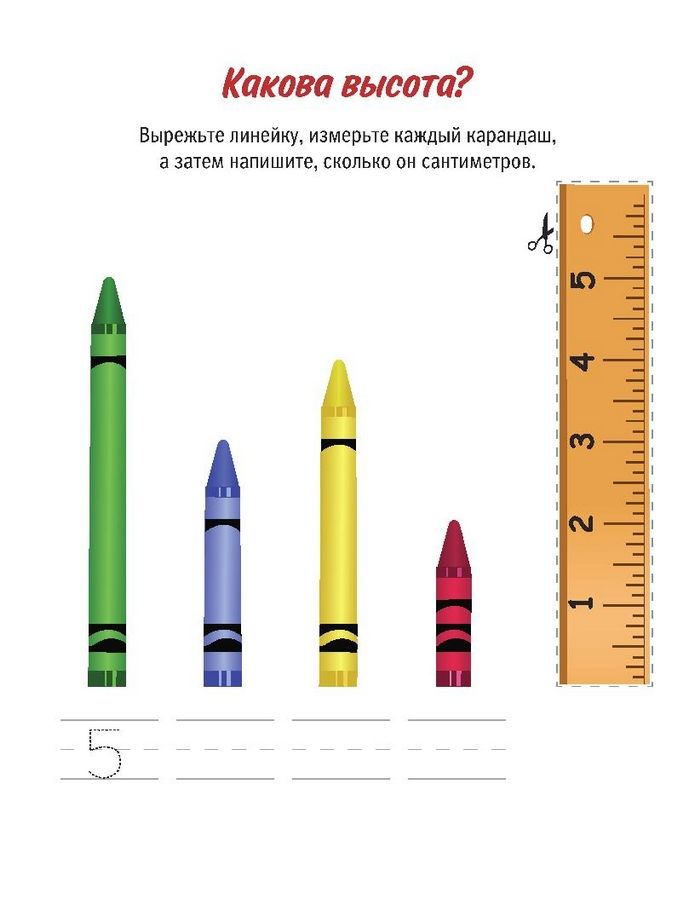 Review red flags to help you tell if your child is growing normally and will reach his predicted height or if he might have a growth hormone problem.
Review red flags to help you tell if your child is growing normally and will reach his predicted height or if he might have a growth hormone problem. - Medications: Some medications, particularly chronic use of corticosteroids (like prednisone), can slow growth.
- Health conditions: Children with some chronic illnesses, such as severe arthritis, untreated celiac disease, or cancer may be shorter than expected.
- Genetic conditions: Children with some genetic conditions can cause either short or tall stature. For example, those with Down Syndrome, Noonan Syndrome, or Turner Syndrome tend to be shorter than other family members, while Marfan Syndrome can cause someone to be taller.
Additionally, exercise, pollution, sleep patterns, climate, fitness, diet, and psychological well-being can also impact growth.
If You Have Concerns about Your Child's Height:
If you are concerned about your child's height or think that your child may be growing too fast or too slowly, talk to your pediatrician. If needed, your pediatrician can order further tests. A simple x-ray of the hand and wrist may show how much growth your child has left. Lab tests can also help find the cause of growth problems and how to treat them. You may also be referred to a pediatric endocrinologist, pediatric geneticist, or other pediatric specialist for further evaluation and treatment.
If needed, your pediatrician can order further tests. A simple x-ray of the hand and wrist may show how much growth your child has left. Lab tests can also help find the cause of growth problems and how to treat them. You may also be referred to a pediatric endocrinologist, pediatric geneticist, or other pediatric specialist for further evaluation and treatment.
Don't delay!
Remember, once your child finishes puberty, growth stops. A short teenager has little or no time to catch up on growth, while a younger child still has time to be treated and grow taller.
- Last Updated
- 1/27/2016
- Source
- Section on Genetics and Birth Defects (Copyright © 2015 American Academy of Pediatrics)
The information contained on this Web site should not be used as a substitute for the medical care and advice of your pediatrician. There may be variations in treatment that your pediatrician may recommend based on individual facts and circumstances.
There may be variations in treatment that your pediatrician may recommend based on individual facts and circumstances.
How to find out how tall a child will be when he grows up: calculator and growth rates
Health
- Photo
- Photo Alto / Legion
pediatrician
In the first year of life, children literally grow by leaps and bounds hours and grow 25 centimeters by their first birthday. Growth hormone is produced in the endocrine gland, which is located in the brain. This happens when the baby is sleeping, which is why healthy and restful sleep is so important. nine0003
“From one to three years old, a child on average gains 10 centimeters a year,” says pediatrician Marina Fedyushina. - From three to six years, the growth rate decreases: the mark on the stadiometer increases by about 4-5 centimeters.
Until the age of 10, there is a slight slowdown, and already from the age of 11 (for girls) and from 13 years (for boys) there is a sharp jump in growth rates. After 40 years, we begin to decrease a little. This is due to fluid loss from the intervertebral discs.”
Place of birth matters
Obviously, growth is due to heredity. It is the genes that determine whether your son will be teased by Gulliver, and your daughter by Thumbelina. Not so simple.
“In 2014, American scientists conducted a large-scale study on the influence of genes on human growth,” says Doctor of Biology Antonina Volkova . - The project was carried out by specialists from 300 institutes, and the number of participants reached 250 thousand people. The experiment proved that human growth is influenced by various gene variations, and there are about 300 hundreds of them. It is important what were your ancestors (not just parents), from whom you got a certain appearance.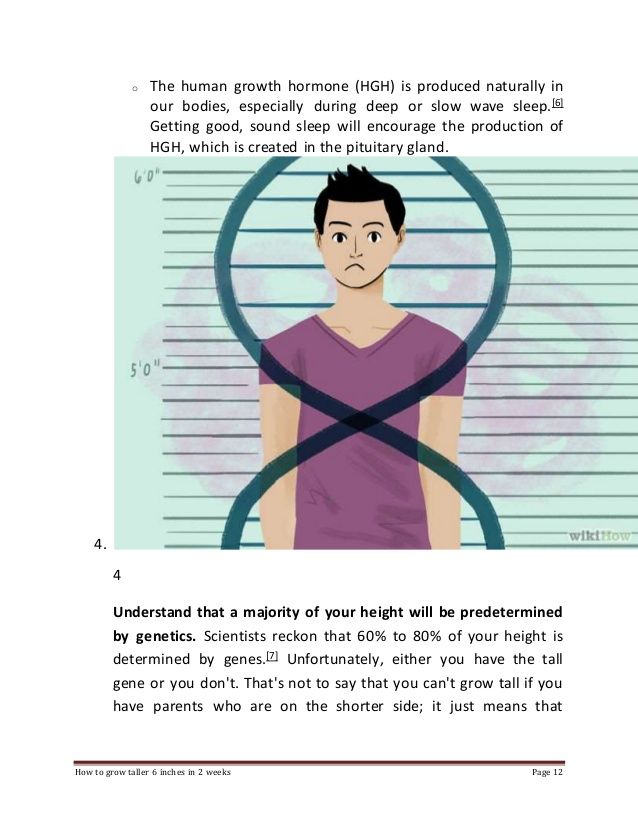 nine0003
nine0003
The scientists also found out that the northerners are much taller than the inhabitants of the southern regions. For the first time, the German biologist Karl Bergman told the world about this, he said that a hot climate contributes to a slowdown in growth processes.
- Photo
- Photo Alto/Legion
Growth Formulas
Doctors have come up with a few simple formulas that can be used to predict where in the ranks your child will stand in physical education classes.
1. The most common formula
Boy height (cm) = (Mother's height + Father's height) * 0.54 - 4.5 (cm)
Example: (165 + 183) * 0.54 - 4.5 (cm) = 183 .4 (cm)
Girl's height = (mother's height + father's height) * 0.51 - 7.5 (cm)
Example: (159 + 173) * 0.51 - 7.5 (cm) = 161.8 (cm)
2.
 Dr. John Hawker's formula
Dr. John Hawker's formula An employee of one of the largest private medical centers in the world, the Mayo Clinic, proposed the following calculations:
The boy's height is = (Father's height + Mother's height): 2 + 6.4
Example: (183 + 165): 2 + 6.4 (cm) = 180.4 (cm)
Girl's height = (Father's height + Mother's height): 2 - 6.4
Example: (173 + 159): 2 - 6.4 (cm) = 159.6 (cm)
Boy's height = (Father's height + Mother's height * 1.08): 2
Example: (183 + 165 * 1.08): 2 = 180.6 (cm)
Girl's height father * 0.923 + mother's height): 2
Example: (173* 0.923 + 159): 2 = 159.3
- Photo
- Image Source/Legion
Reasons:
-
Emotional overloads,
-
Irlear nutrition,
-
Chronic diseases,
-
Climate and geographical conditions,
-
Chromosomal disorders (for example, Daun's disease), 9,000,9000, 9,0000003
-
malformations of bones.
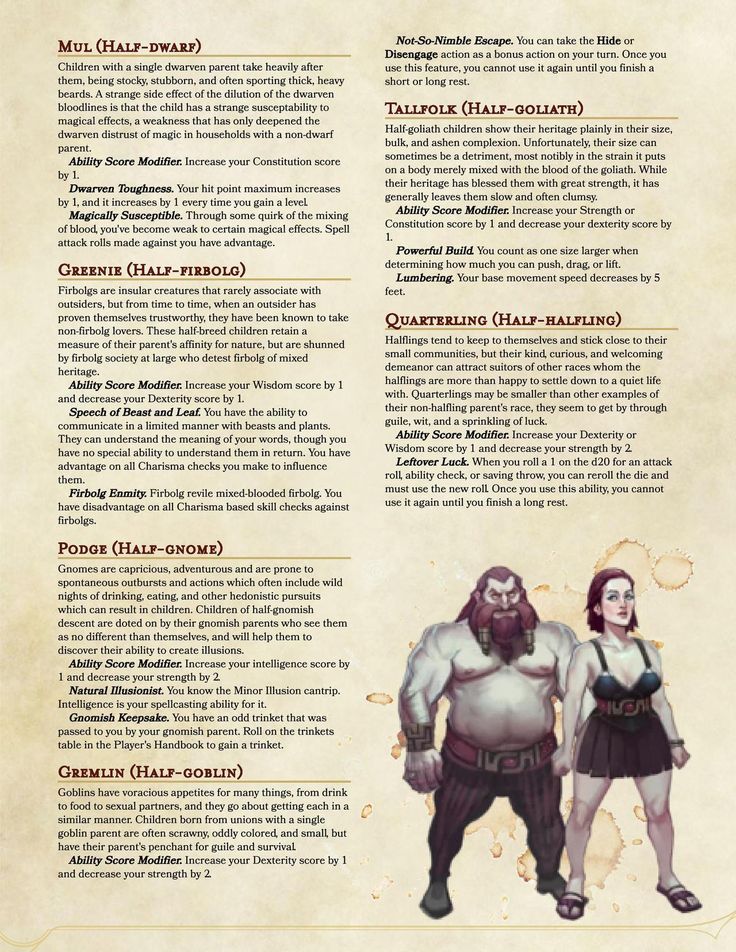
4. The Smirnov-Gorbunov formula
The authors of the sensational article "Short stature in childhood" Professor Vladimir Smirnov and endocrinologist Gleb Gorbunov also wondered what height a child would have in adulthood. This formula allows an error of as much as 8 cm:
Boy's height = (Father's height + Mother's height + 12.5): 2 ±8
Example: (183 + 165 + 12.5): 2 ±8 = 188.25 (cm) or 172.25 (cm)
Girl's height = (father's height + mother's height - 12.5): 2 ±8
Example: (173 + 159 - 12.5): 2 ±8 = 167.75 (cm) or 151.75 (cm) )
5. The formula for the growth of a child per year
According to the World Health Organization, the normal height of a one-year-old boy is considered to be from 71 to 80.5 cm, for girls - from 68.9 to 79.2 cm. If you want to know what will be your baby by the age of 20, it is necessary to add 100 cm (for a boy) and 95 (for a girl) to the height that the baby reached at 12 months. nine0003
Based on this formula, boys can only grow to 180. 5 cm and girls to 174.2. How then to be with Ivan Urgant, who has reached a height of 195 cm?
5 cm and girls to 174.2. How then to be with Ivan Urgant, who has reached a height of 195 cm?
Professional sports can also change appearance. If you don’t want a modeling career for your child, then feel free to give it to gymnastics: a serious load on the joints and bones, spinal injuries contribute to problems with the development of the skeleton, children grow poorly. Although the famous gymnast Laysan Utyasheva has grown to 167 centimeters, this is quite a normal height for a girl. But swimming, football, hockey, tennis, volleyball will allow you to become taller, faster and stronger. nine0003
Pediatricians themselves do not particularly trust these methods of calculating height.
“There will always be errors,” continues Marina Fedyushina. - The growth rate, in addition to heredity, is influenced by various factors. First of all, this, of course, is the state of the endocrine glands. Do not discount nutrition and lifestyle. Lack of vitamins, smoking and alcohol slow down the growth of the child”
Julia Evteeva
0001
Parenting
- Photo
- peopleimages.com/AdobeStock
Admit it, you want to know how your baby will grow up? Looking into the future is always interesting. Specialists came to the aid of parents: pediatricians and mathematicians. Now, after all, scientists can predict anything, except, perhaps, the weather.
All together they have compiled several formulas by which you can calculate how tall your baby will reach for years, that way, by the age of 18-20. We have tested all these formulas. And here's what we got. nine0003
1 of 4
Height meter for children Woozzee
Get the price
This beautiful children's stadiometer will become a real decoration of a child's room. Thanks to its bright and colorful design, the process of measuring height will be a real pleasure for your child.
Advertising. Yandex LLC
2 out of 4
Height meter RD&Co
Get the price
Colorful stadiometer - a sticker for the nursery. Height - from 30 to 180cm. Sticks to all types of surfaces. Eco-friendly, safe, included stickers for growth marks. nine0003
Height - from 30 to 180cm. Sticks to all types of surfaces. Eco-friendly, safe, included stickers for growth marks. nine0003
Advertising. Yandex LLC
3 out of 4
Height meter electronic REP
Ask for price
Larger device for those who approach the task responsibly.
Advertising. Yandex LLC
4 out of 4
Height measuring tape KAWE
Ask for price
KaWe Person-Check is used to determine height. The comfort of using the wall-mounted stadiometer is due to the bar that can be lowered to the bottom. nine0003
Advertising. Yandex LLC
Method No. 1: formula of the 70s
Everything is simple here. This method of calculating growth has been used since the 1970s. All you need is to know the height of the parents. To calculate the height of a girl, the formula will look like this: dad's height + mom's height -13 and divide the result by 2. For a boy, it's exactly the same, but you don't need to subtract 13, but add.
For a boy, it's exactly the same, but you don't need to subtract 13, but add.
So, let's check. Natasha's example: dad's height is 184 cm, mom's height is 164 cm. see, getting out of all the forecasts. nine0003
- Photo
- Getty Images
Misha's example. Mom and dad are 165 and 176 cm respectively. We calculate: 165 + 176 = 341. Plus 13 - we get 354. Divide by two - 177 cm. But Misha ruined everything, reaching up to 196 cm ( read also : How to dress a plump woman of small stature - these tips will come in handy for everyone).
An example of Tolya. Yes, Misha's example is still not entirely indicative, we agree. Therefore, we also took Tolya - he is more human in growth. The height of his mom and dad is 165 and 187 cm. Substitute in the formula, we get the result - 182.5 cm. Surprisingly accurate - Anatoly's height is 183 cm.
Surprisingly accurate - Anatoly's height is 183 cm.
Method #2: magic factor
For this formula, you also need only the height of the parents. To find out the height of the boy, the height of mom and dad in centimeters must be added and multiplied by a factor of 0.54, and subtract 4.5 cm from the result - this is for boys. In the case of a girl, the coefficient will be equal to 0.51, and more must be subtracted from the result - 7.5 cm.
We consider. Natasha's example: (164 + 184) x 0.51 = 177.48. We subtract 7.5 cm - it remains almost 170 cm. The discrepancy with reality was 10 cm.
Misha's example. 341 × 0.54 - 4.5 = 179.6. Hm. Apparently, Mikhail, with his monstrous growth, broke all the conclusions of mathematicians.
An example of Tolya. 352 x 0.54 = 190.08. We subtract 4.5, we get 185.58. Almost grown. Method #3: Hawker's Formula The bottom line is this: you need (of course) to add up the height of mom and dad, divide by two.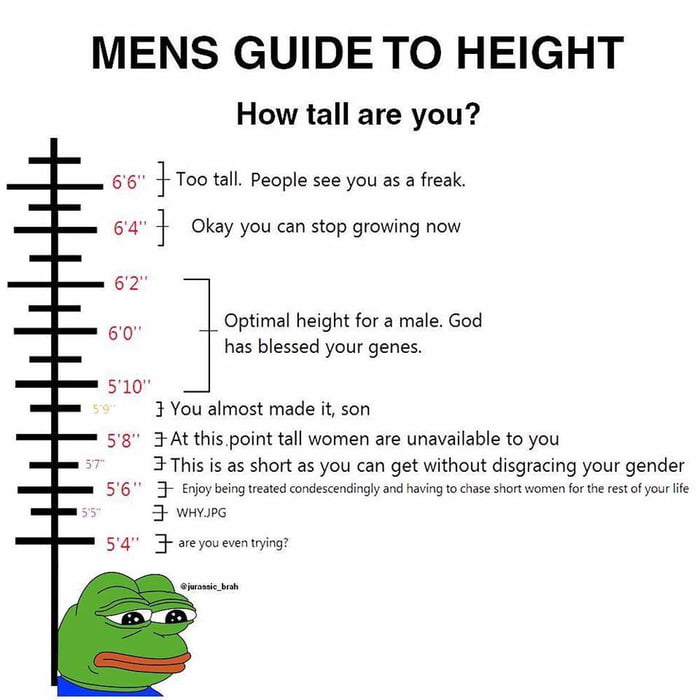 If you are calculating the height of a boy, add 6.4. In the case of a girl, subtract all the same 6.4. nine0003
If you are calculating the height of a boy, add 6.4. In the case of a girl, subtract all the same 6.4. nine0003
Natasha's example. 348/2 \u003d 174. Subtract 6.4 - it turns out that Natasha should not have grown above 167.6 cm. But she grew up ( read also : The most attractive female height and weight according to men).
An example of Tolya. Yes, we decided to abandon Misha because of his Uncle Styopa syndrome. Anatoly's mom's height is 165 cm, dad's is 187. We count: 165 + 187 = 352. Divide by 2: 176. Plus 6.4 - we get 182.4. Bingo! Recall that Anatoly's height is 183 cm.
Method No. 4: Karkus formula
Here the method of calculating the final height of a boy and a girl is slightly different. Let's start with Natasha. The formula prescribes to multiply the father's height in centimeters by a factor of 0.923, add the mother's height to the resulting number, and divide the total amount by two. We consider: 184 × 0.923 \u003d 169.832. Plus mom's height: 333.832. We divide everything by two: 166.9 cm. Again, by.
We consider: 184 × 0.923 \u003d 169.832. Plus mom's height: 333.832. We divide everything by two: 166.9 cm. Again, by.
Now let's take care of boy Tolya . It’s simpler here: the sum of the growth of mom and dad needs to be multiplied by a factor of 1.08, the result is divided by 2. It turns out 190 cm. They didn’t hit - they overestimated the height of our test subject by 7 cm. I wonder if this method will work with Misha? Let's try. We add, multiply, divide - it turns out 184 cm. It didn’t work out.
- Photo
- Getty Images
Method No. 5: allowable error 183.
Natasha's example. nine0024 To calculate the girl's height, the formula prescribes to add the height of the father and mother, subtract 12.5 cm from the sum, and divide the result by two. The result will be the final height of the child, plus or minus 8 cm. We consider: 164 + 184 - 12.5 = 335.5. We divide by two, it turns out 167.8. Even if you add 8 cm of error, you can't reach 180.
We consider: 164 + 184 - 12.5 = 335.5. We divide by two, it turns out 167.8. Even if you add 8 cm of error, you can't reach 180.
An example of Tolya. Boys are calculated a little differently. Again, we add the height of mom and dad, but we add 12.5, and do not minus. It turns out 364.5. Divide by two - 182.3. Right on the bull's-eye, without any errors. nine0003
Method No. 6: growth of a child per year
We don't need either mom or dad here, only the growth of a baby at the age of 12 months. To calculate the girl's height, you need to add 95 cm to it. In the case of a boy, you need to add 100 cm.
Natasha's example. Our girl was 69 cm tall a year. It turns out that according to this formula, she should not have grown above 164 cm. But she did.
An example of Tolya. Our boy at 12 months reached the mark of 71 cm. And, it turns out, he outgrew the forecast by as much as 12 cm.
- Photo
- Getty Images
Method number 7: purely mathematical
We will not torment you with the justification of this formula, it was deduced by highbrow mathematicians.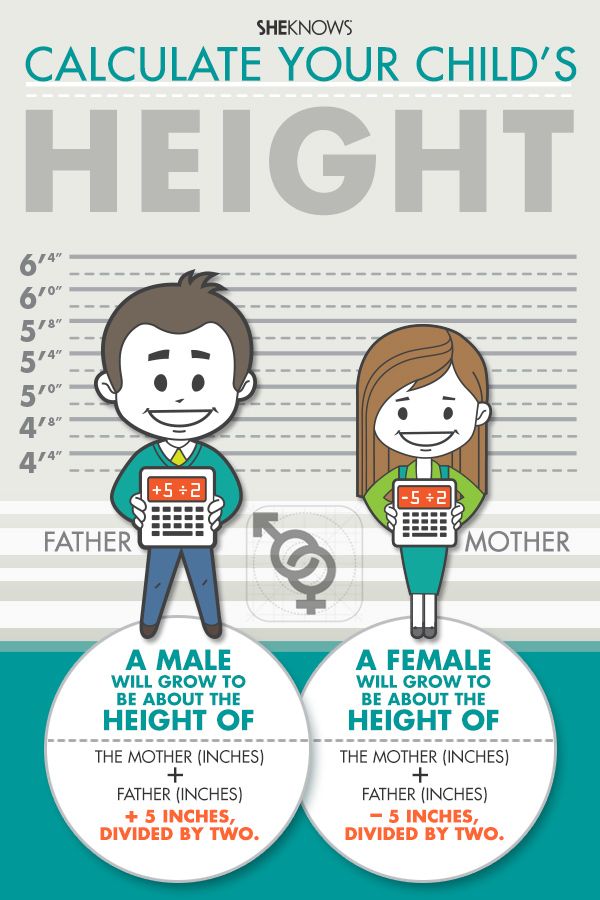 Yes, and it doesn't matter. The main thing is to understand if the method works. This is what we'll do.
Yes, and it doesn't matter. The main thing is to understand if the method works. This is what we'll do.
An example of Natasha. Mathematicians propose to calculate the girl’s height according to the formula: mom’s height + dad’s height, multiply the amount by a factor of 0.505, and subtract 5 cm from the resulting number. We count: 164 + 184 = 348, multiply by 0.505 - we get 175.7. Almost. But after all, it is necessary to take away another 5 cm. As a result, we get a miserable 170.7 cm. We did not reach it a little. nine0003
An example of Tolya. We evaluate the growth of the boy a little differently. The coefficient will be equal to 0.57, and from the final number you need to subtract not 5 cm, but as much as 14 and a half. We consider: 165 + 187 \u003d 352. Multiply by 0.57, it turns out 200.64. Subtract 14.5 - we get 186 cm with a small tail. Very close!
It is worth remembering that a lot of things affect the growth of a child: from nutrition to sports.

